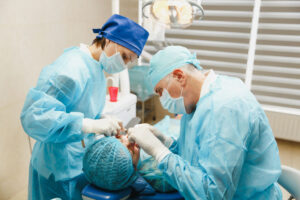 LANAP laser treatment can be an excellent alternative to gum surgery for many patients. But what exactly is LANAP treatment, and how does it differ from gum surgery? This article will provide a detailed comparison of these available treatments for patients suffering from periodontal disease.
LANAP laser treatment can be an excellent alternative to gum surgery for many patients. But what exactly is LANAP treatment, and how does it differ from gum surgery? This article will provide a detailed comparison of these available treatments for patients suffering from periodontal disease.
Gum Surgery
In conventional gum surgery for periodontal disease, the gum tissue is pulled back from the periodontal pocket with a scalpel. This improves accessibility to the area for your doctor. Some of the gum tissue will then be removed and sutured to reduce the depth of the pocket. After this step has been completed, your doctor may complete a bone or tissue graft to join the root of the tooth with the gums.
Unfortunately, gum surgery can be painful for the patient, and pain medications are typically required during the recovery process. This invasive procedure can also lead to gum line recession, given that some of the gum tissue has to be removed and sutured.
LANAP Laser Treatment
LANAP laser treatment is a scientifically-proven treatment alternative to gum surgery for periodontal disease. An acronym for “Laser-Assisted New Attachment Procedure,” LANAP treats periodontal disease by:
- Sterilizing the infected gum tissue
- Destroying bacteria
- Aiding the healthy gum tissue in reattaching to the teeth
LANAP is less painful and more successful than gum surgery for periodontal disease. It offers precision in targeting the damaged tissue while leaving the surrounding healthy tissue unaffected. This allows for a faster recovery period and no gum recession as a result of the procedure.
Typically, LANAP treatments are completed in two visits. One-half of the mouth will be completed in each visit, as well as conventional scaling and root planing. This approach prevents the loss of more bone or soft tissue attachment in patients with periodontal disease.
If you’re interested in LANAP laser treatment for gum disease or infection, contact us today to learn more!
